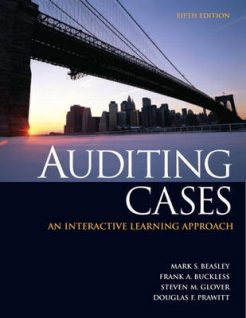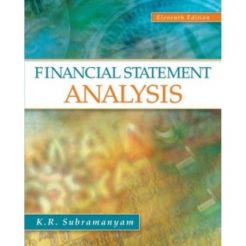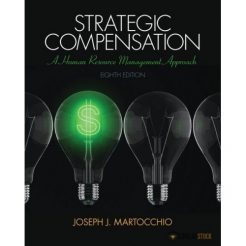Description
Financial Accounting Harrison 10th Edition Test Bank
Financial Accounting Harrison Horngren 10th Edition Test Bank
***THIS IS NOT THE ACTUAL BOOK. YOU ARE BUYING the Test Bank in e-version of the following book***
Name: Financial Accounting
Author: Harrison Horngren
Edition: 10th
ISBN-10: 0133427536
Type: Test Bank
– The test bank is what most professors use an a reference when making exams for their students, which means there’s a very high chance that you will see a very similar, if not exact the exact, question in the test!
– The file is either in .doc, .padf, excel, or zipped in the package and can easily be read on PCs and Macs.
– Delivery is INSTANT. You can download the files IMMEDIATELY once payment is done.
If you have any questions, please feel free to contact us. Our response is the fastest. All questions will always be answered in 6 hours., most of the time within 30mins
We also faced similar difficulities when we were students, and we understand how you feel.
But now, with the Financial Accounting Test Bank, you will be able to
* Anticipate the type of the questions that will appear in your exam.
* Reduces the hassle and stress of your student life.
* Improve your studying and also get a better grade!
* Get prepared for examination questions.
*Can save you time and help you understand the material.
This is the quality of service we are providing and we hope to be your helper.
Delivery is in the next moment. Test Bank is accurate.
Prepare to receive your Financial Accounting Test Bank in the next moment.
If you have any questions, or would like a receive a sample chapter before your purchase, please contact us at inquiry@testbankcorp.com
Financial Accounting Test Bank
Financial Accounting Harrison Horngren 10th Edition Test Bank ISBN: 0133427536
Financial Accounting, 10e (Harrison/Horngren/Thomas)
Chapter 1 The Financial Statements
1.1 Learning Objective 1-1
1) Accounting is an information system that measures business activities.
Answer: TRUE
Diff: 1
LO: 1-1
AACSB: Reflective Thinking
AICPA Bus Persp: Legal/Regulatory
AICPA Functional: Measurement
2) Bookkeeping is the mechanical part of accounting.
Answer: TRUE
Diff: 1
LO: 1-1
AACSB: Reflective Thinking
AICPA Bus Persp: Legal/Regulatory
AICPA Functional: Measurement
3) Accounting is often called the language of business.
Answer: TRUE
Diff: 1
LO: 1-1
AACSB: Reflective Thinking
AICPA Bus Persp: Legal/Regulatory
AICPA Functional: Measurement
4) Accounting produces financial statements, which report information about a business entity.
Answer: TRUE
Diff: 1
LO: 1-1
AACSB: Reflective Thinking
AICPA Bus Persp: Legal/Regulatory
AICPA Functional: Measurement, Reporting
5) The accounting process begins and ends with people making decisions.
Answer: TRUE
Diff: 1
LO: 1-1
AACSB: Reflective Thinking
AICPA Bus Persp: Legal/Regulatory
AICPA Functional: Measurement
6) Accounting information is used by investors and lenders, but not by regulatory bodies.
Answer: FALSE
Diff: 1
LO: 1-1
AACSB: Reflective Thinking
AICPA Bus Persp: Industry Sector, Legal/Regulatory
AICPA Functional: Measurement, Reporting
7) Habitat for Humanity does not use accounting information since they are not concerned about making a profit.
Answer: FALSE
Diff: 1
LO: 1-1
AACSB: Reflective Thinking
AICPA Bus Persp: Industry Sector, Legal/Regulatory
AICPA Functional: Measurement, Reporting
8) The business records of a sole proprietorship should include the proprietor’s personal assets such as a house.
Answer: FALSE
Diff: 1
LO: 1-1
AACSB: Reflective Thinking
AICPA Bus Persp: Legal/Regulatory
AICPA Functional: Measurement
9) Accounting:
A) measures business activities.
B) processes data into reports and communicates the data to decision makers.
C) is often called the language of business.
D) is all of the above.
Answer: D
Diff: 2
LO: 1-1
AACSB: Reflective Thinking
AICPA Bus Persp: Legal/Regulatory
AICPA Functional: Measurement, Reporting
10) A disadvantage of general partnerships is:
A) double taxation of distributed profits.
B) the partnership’s assets are commingled with each partner’s personal assets.
C) state rules and regulations must be followed.
D) each partner may conduct business in the name of the entity and make agreements that legally bind all partners.
Answer: D
Diff: 2
LO: 1-1
AACSB: Reflective Thinking
AICPA Bus Persp: Legal/Regulatory
AICPA Functional: Measurement
11) Which of the following statements is TRUE for a limited liability company?
A) Members have unlimited liability for the debts of the business.
B) Members have limited liability for the debts of the business.
C) Only the limited partners have limited liability for the debts of the business.
D) The general partner has unlimited liability for the debts of the business.
Answer: B
Diff: 2
LO: 1-1
AACSB: Reflective Thinking
AICPA Bus Persp: Legal/Regulatory
AICPA Functional: Measurement
12) Which of the following statements is TRUE for a limited liability partnership?
A) The partners all have limited liability for the debts of the partnership.
B) The partners all have limited liability for the acts of the other partners.
C) The general partner has unlimited liability for the debts of the partnership.
D) The limited partners have unlimited liability for the debts of the partnership.
Answer: C
Diff: 2
LO: 1-1
AACSB: Reflective Thinking
AICPA Bus Persp: Legal/Regulatory
AICPA Functional: Measurement
13) Which of the following statements is TRUE for a proprietorship?
A) Legally, a proprietorship is separate from the proprietor.
B) For accounting purposes, a proprietorship is separate from the proprietor.
C) For accounting purposes, a proprietorship is not separate from the proprietor.
D) A and B
Answer: B
Diff: 2
LO: 1-1
AACSB: Reflective Thinking
AICPA Bus Persp: Legal/Regulatory
AICPA Functional: Measurement
14) Federal income taxes are paid by ________ in a limited liability company.
A) the company
B) limited partners only
C) general partners only
D) members
Answer: D
Diff: 2
LO: 1-1
AACSB: Reflective Thinking
AICPA Bus Persp: Legal/Regulatory
AICPA Functional: Measurement, Reporting
15) Which of the following statements is TRUE for a limited liability partnership?
A) The partnership pays no federal income taxes.
B) Only the limited partners pay federal income taxes on their shares of the partnership’s profits.
C) Only the general partner pays federal income taxes on his or her share of the partnership’s profits.
D) Only the members pay federal income taxes on their shares of the partnership’s profits.
Answer: A
Diff: 2
LO: 1-1
AACSB: Reflective Thinking
AICPA Bus Persp: Legal/Regulatory
AICPA Functional: Measurement, Reporting
16) Which statement is TRUE about partnerships?
A) Legally, a partnership is separate from the partners.
B) A partnership has one capital account.
C) For accounting purposes, a partnership is separate from the partners.
D) For accounting purposes, a partnership is not separate from the partners.
Answer: C
Diff: 2
LO: 1-1
AACSB: Reflective Thinking
AICPA Bus Persp: Legal/Regulatory
AICPA Functional: Measurement
17) Which of the following have unlimited liability for a company’s debts?
A) owners of a corporation
B) members of a limited liability company
C) limited partners in a limited liability partnership
D) general partner in a limited liability partnership
Answer: D
Diff: 2
LO: 1-1
AACSB: Reflective Thinking
AICPA Bus Persp: Legal/Regulatory
AICPA Functional: Measurement
18) Which of the following entities pays federal income taxes?
A) limited liability partnership
B) general partnership
C) limited liability company
D) corporation
Answer: D
Diff: 2
LO: 1-1
AACSB: Reflective Thinking
AICPA Bus Persp: Legal/Regulatory
AICPA Functional: Measurement
19) The two types of accounting are:
A) profit and nonprofit.
B) financial and managerial.
C) internal and external.
D) bookkeeping and decision-oriented.
Answer: B
Diff: 2
LO: 1-1
AACSB: Reflective Thinking
AICPA Bus Persp: Legal/Regulatory
AICPA Functional: Measurement, Reporting
20) Decision makers who use accounting information include:
A) creditors.
B) the Internal Revenue Service.
C) the Securities and Exchange Commission.
D) all of the above.
Answer: D
Diff: 2
LO: 1-1
AACSB: Reflective Thinking
AICPA Bus Persp: Legal/Regulatory
AICPA Functional: Measurement
21) The ________ is elected by the stockholders and is responsible for setting policy and appointing officers.
A) board of directors
B) chief executive officer (CEO)
C) chief financial officer (CFO)
D) advisory council
Answer: A
Diff: 2
LO: 1-1
AACSB: Reflective Thinking
AICPA Bus Persp: Legal/Regulatory
AICPA Functional: Measurement
22) Which type of business organization transacts the most business and is the largest in terms of assets, income, and number of employees?
A) Proprietorship
B) Partnership
C) Limited-liability company
D) Corporation
Answer: D
Diff: 2
LO: 1-1
AACSB: Reflective Thinking
AICPA Bus Persp: Legal/Regulatory
AICPA Functional: Measurement
23) The entity assumption does NOT apply to a:
A) proprietorship.
B) limited liability partnership.
C) limited-liability company.
D) The entity assumption applies to all the above.
Answer: D
Diff: 2
LO: 1-1
AACSB: Reflective Thinking
AICPA Bus Persp: Legal/Regulatory
AICPA Functional: Measurement
24) Which of the following is a TRUE statement about the characteristics of partnerships?
A) Limited partners have mutual agency and unlimited liability for the partnership’s debts.
B) General partners have mutual agency and limited liability for the partnership’s debts.
C) Net income and loss of the partnership “flows through” to the partners.
D) The partnership agreement must be in writing.
Answer: C
Diff: 2
LO: 1-1
AACSB: Reflective Thinking
AICPA Bus Persp: Legal/Regulatory
AICPA Functional: Measurement
25) Owners of an LLC are called:
A) partners.
B) proprietors.
C) members.
D) stockholders.
Answer: C
Diff: 1
LO: 1-1
AACSB: Reflective Thinking
AICPA Bus Persp: Legal/Regulatory
AICPA Functional: Measurement
26) Advantages of a corporation include:
A) each stockholder can enter into agreements that legally bind all the stockholders.
B) the double taxation of distributed profits.
C) limited liability of the stockholders for the corporation’s debts.
D) each stockholder can conduct business in the name of the corporation.
Answer: C
Diff: 1
LO: 1-1
AACSB: Reflective Thinking
AICPA Bus Persp: Legal/Regulatory
AICPA Functional: Measurement
27) Shareholders of a corporation:
A) have limited liability for the corporation’s debts.
B) have unlimited liability for the corporation’s debts.
C) have unlimited liability for the actions of other stockholders.
D) receive dividends from the corporation without having to pay tax on the distribution.
Answer: A
Diff: 2
LO: 1-1
AACSB: Reflective Thinking
AICPA Bus Persp: Legal/Regulatory
AICPA Functional: Measurement
28) An important fact to consider when determining how to organize a business is that:
A) members of an LLC have unlimited liability and are taxed like members of a partnership.
B) for accounting purposes, a proprietorship is a distinct entity from the proprietor.
C) the records of a partnership can include each partner’s personal assets and debts.
D) the proprietor and the proprietorship are separate legal entities.
Answer: B
Diff: 1
LO: 1-1
AACSB: Reflective Thinking
AICPA Bus Persp: Legal/Regulatory
AICPA Functional: Measurement
1.2 Learning Objective 1-2
1) Generally accepted accounting principles, or GAAP, are the rules and procedures established by the Securities and Exchange Commission.
Answer: FALSE
Diff: 2
LO: 1-2
AACSB: Reflective Thinking
AICPA Bus Persp: Legal/Regulatory
AICPA Functional: Measurement, Reporting
2) The SEC establishes international financial reporting standards.
Answer: FALSE
Diff: 1
LO: 1-2
AACSB: Reflective Thinking
AICPA Bus Persp: International/Global
AICPA Functional: Measurement, Reporting
3) The fundamental qualitative characteristics of accounting information are relevance and reliability.
Answer: FALSE
Diff: 2
LO: 1-2
AACSB: Reflective Thinking
AICPA Bus Persp: Legal/Regulatory
AICPA Functional: Measurement, Reporting
4) Another name for the continuity assumption is the going-concern assumption.
Answer: TRUE
Diff: 1
LO: 1-2
AACSB: Reflective Thinking
AICPA Bus Persp: Legal/Regulatory
AICPA Functional: Measurement
5) Following U.S. GAAP, the carrying value of a building can be increased to its fair value.
Answer: FALSE
Diff: 2
LO: 1-2
AACSB: Reflective Thinking
AICPA Bus Persp: Legal/Regulatory
AICPA Functional: Measurement
6) Accounting is moving in the direction of reporting more and more assets and liabilities at their fair values.
Answer: TRUE
Diff: 1
LO: 1-2
AACSB: Reflective Thinking
AICPA Bus Persp: Legal/Regulatory
AICPA Functional: Measurement
7) Since we live in a global economy, all countries have adopted the same accounting standards for business transactions.
Answer: FALSE
Diff: 1
LO: 1-2
AACSB: Reflective Thinking
AICPA Bus Persp: International/Global
AICPA Functional: Measurement, Reporting
8) Characteristics of faithfully representative information do NOT include:
A) complete.
B) neutral.
C) accurate.
D) relevant.
Answer: D
Diff: 1
LO: 1-2
AACSB: Reflective Thinking
AICPA Bus Persp: Legal/Regulatory
AICPA Functional: Measurement, Reporting
9) Enhancing qualitative characteristics of accounting information do NOT include:
A) comparability.
B) verifiability.
C) timeliness.
D) materiality.
Answer: D
Diff: 1
LO: 1-2
AACSB: Reflective Thinking
AICPA Bus Persp: Legal/Regulatory
AICPA Functional: Measurement, Reporting
10) The process of verifying accounting information in financial statements is undertaken by:
A) the Securities and Exchange Commission.
B) internal auditors only.
C) external auditors only.
D) internal and external auditors.
Answer: D
Diff: 1
LO: 1-2
AACSB: Reflective Thinking
AICPA Bus Persp: Legal/Regulatory
AICPA Functional: Measurement, Reporting
11) Information must be sufficiently transparent so that it makes sense to reasonably informed users of the financial statements, such as creditors. This qualitative characteristic of information is called:
A) verifiability.
B) faithful representative.
C) relevant.
D) understandability.
Answer: D
Diff: 1
LO: 1-2
AACSB: Reflective Thinking
AICPA Bus Persp: Legal/Regulatory
AICPA Functional: Measurement, Reporting
12) A company uses LIFO to determine the cost of goods sold each year. This inventory method always results in the lowest possible net income. This is an example of:
A) cost benefit constraint.
B) materiality.
C) verifiability.
D) consistency.
Answer: D
Diff: 1
LO: 1-2
AACSB: Reflective Thinking
AICPA Bus Persp: Legal/Regulatory
AICPA Functional: Measurement, Reporting
13) The fair value of a plant asset is equal to:
A) the amount the business could sell the asset for.
B) the amount of cash paid plus the dollar value of noncash consideration given in exchange for the plant asset at acquisition.
C) the amount of cash paid plus the loan taken out to finance the purchase of the plant asset.
D) the amount a company can receive for the asset when sold in order to go out of business.
Answer: A
Diff: 1
LO: 1-2
AACSB: Reflective Thinking
AICPA Bus Persp: Legal/Regulatory
AICPA Functional: Measurement
14) In 1960, Johnson Company purchased a building for $100,000. In 2013, a real estate professional says the building has a fair value of $1,000,000. In 2013, a similar building down the street recently sold for $900,000. What value is reported for the building on the balance sheet at December 31, 2013?
A) $100,000
B) $550,000
C) $900,000
D) $1,000,000
Answer: A
Diff: 1
LO: 1-2
AACSB: Analytical Thinking
AICPA Bus Persp: Legal/Regulatory
AICPA Functional: Measurement, Reporting
15) Which statement is FALSE?
A) International Financial Reporting Standards are used by many countries in the world.
B) U.S. Generally Accepted Accounting Principles are used by many countries in the world.
C) The Financial Accounting Standards Board is working with the International Accounting Standards Board to develop similar accounting standards.
D) For many years, U.S. Generally Accepted Accounting Principles were considered to be the superior set of accounting standards in the world.
Answer: B
Diff: 1
LO: 1-2
AACSB: Reflective Thinking
AICPA Bus Persp: International/Global
AICPA Functional: Measurement, Reporting
16) In order to compare the financial statements of Toyota Corporation to the financial statements of General Motors, it would be preferable to use _________.
A) U.S. Generally Accepted Accounting Principles for General Motors and International Financial Reporting Standards for Toyota.
B) U.S. Generally Accepted Accounting Principles for both companies.
C) International Financial Reporting Standards for both companies.
D) U.S. Generally Accepted Accounting Principles for Toyota Corporation and International Financial Reporting Standards for General Motors.
Answer: C
Diff: 1
LO: 1-2
AACSB: Reflective Thinking
AICPA Bus Persp: International/Global
AICPA Functional: Measurement, Reporting
17) The International Accounting Standards Board is responsible for establishing:
A) the code of professional conduct for accountants.
B) the Securities and Exchange Commission.
C) Generally Accepted Accounting Principles used in the United States.
D) International Financial Reporting Standards.
Answer: D
Diff: 2
LO: 1-2
AACSB: Reflective Thinking
AICPA Bus Persp: International/Global
AICPA Functional: Measurement, Reporting
18) Which of the following statements is FALSE?
A) The Securities and Exchange Commission is investigating whether all U.S. public companies should adopt International Financial Reporting Standards.
B) The advantage of a uniform set of global accounting standards is that financial statements from a U.S. company will be comparable to those of a foreign company.
C) In the long run, a uniform set of global accounting standards will reduce the costs of doing business globally.
D) With a uniform set of global accounting standards, companies will have to produce multiple versions of their financial statements.
Answer: D
Diff: 2
LO: 1-2
AACSB: Reflective Thinking
AICPA Bus Persp: International/Global
AICPA Functional: Measurement, Reporting
19) Which of the following is a CORRECT statement about GAAP and IFRS?
A) IFRS prefers valuing assets at historical cost while GAAP prefers using fair value.
B) IFRS is more “rules-based” than GAAP.
C) The FASB and the IASB are working towards convergence of standards.
D) The SEC will require all companies to use IFRS beginning in 2013.
Answer: C
Diff: 2
LO: 1-2
AACSB: Reflective Thinking
AICPA Bus Persp: International/Global
AICPA Functional: Measurement, Reporting







Reviews
There are no reviews yet.